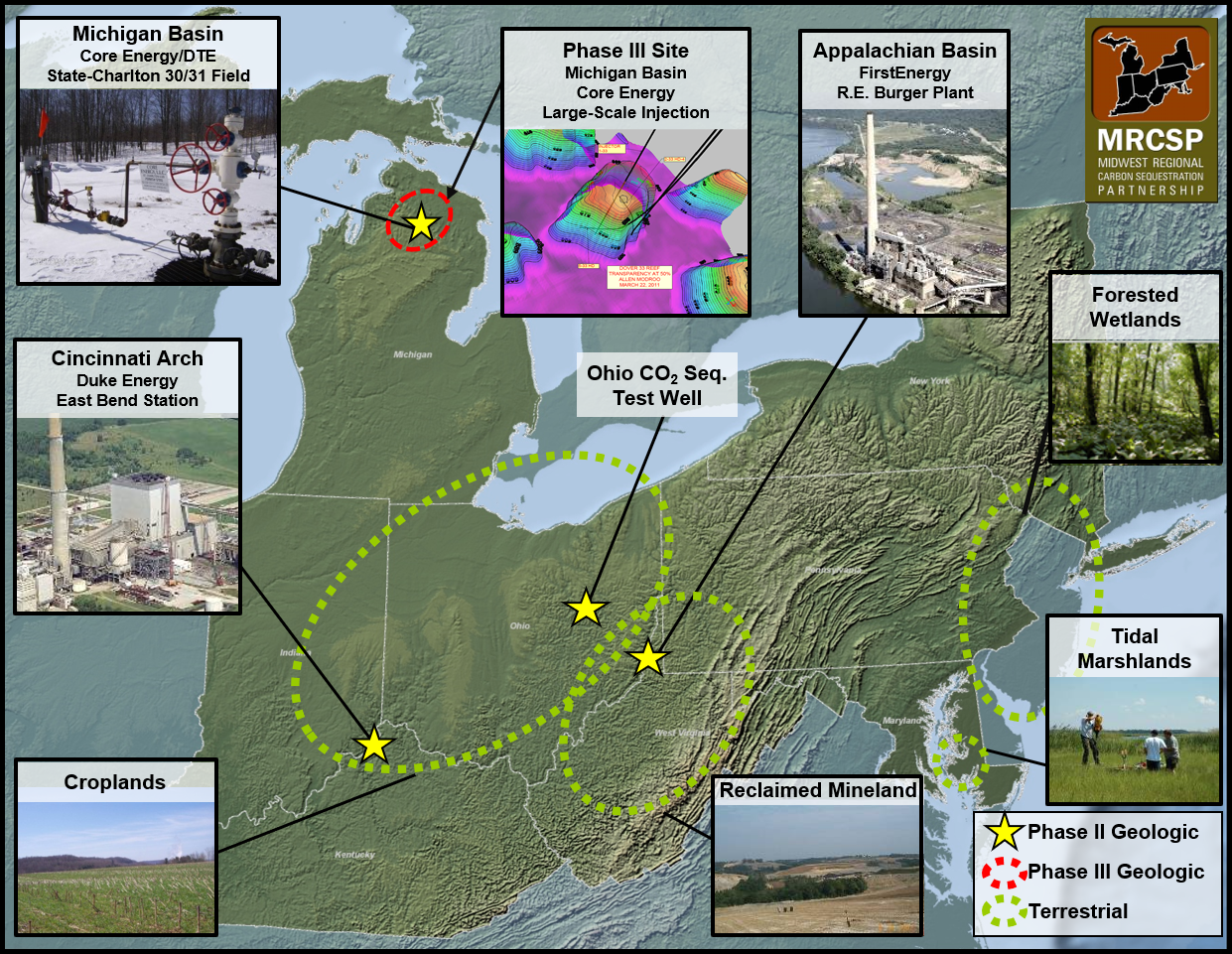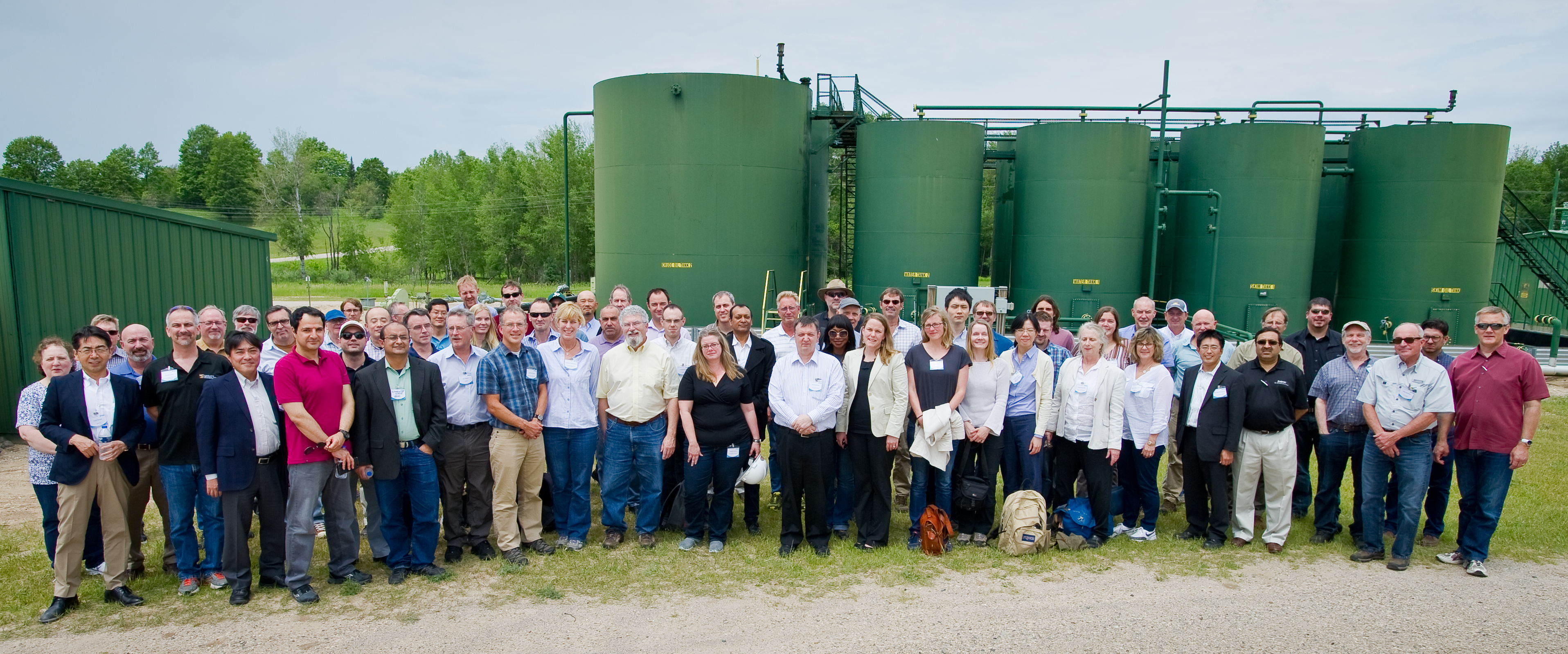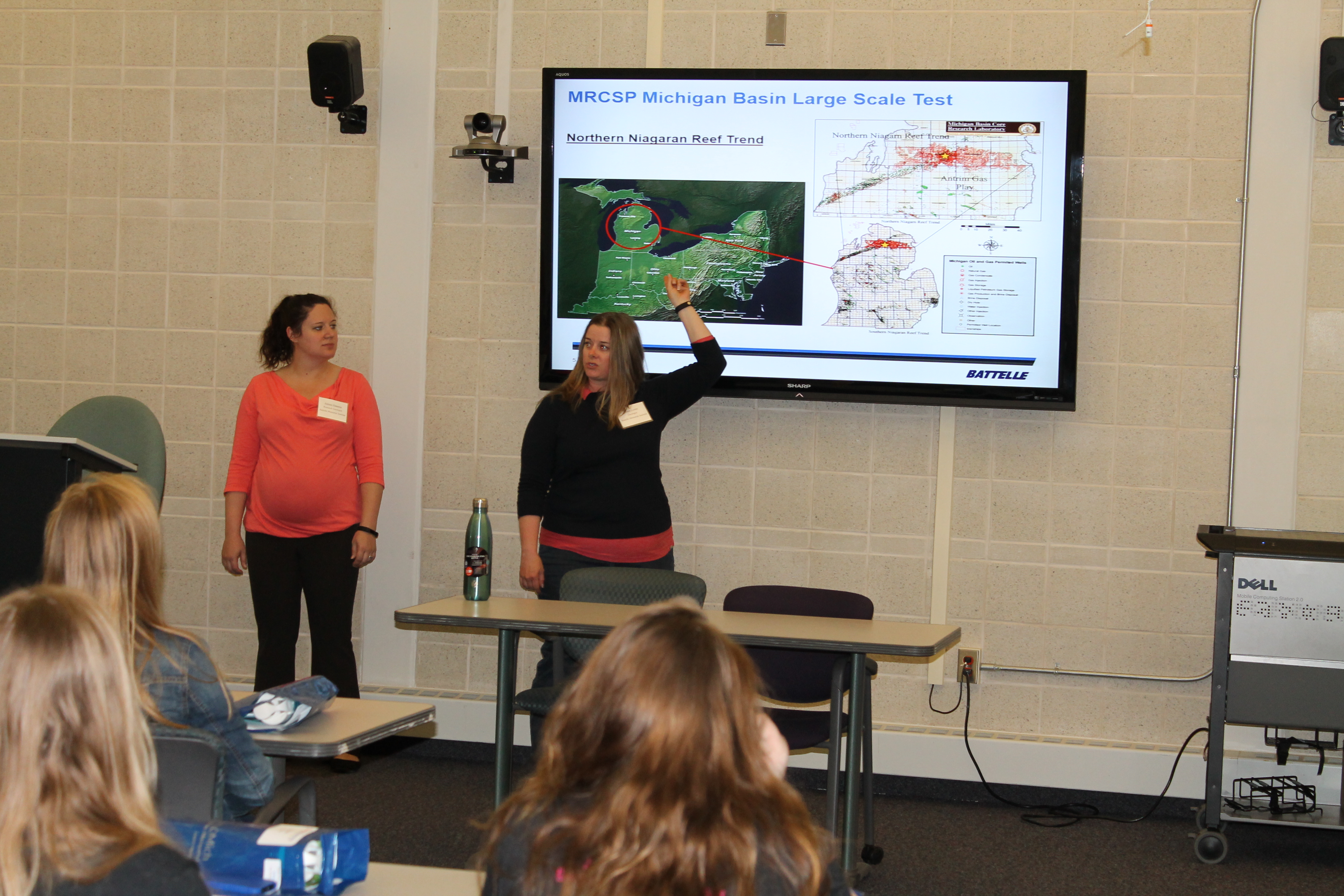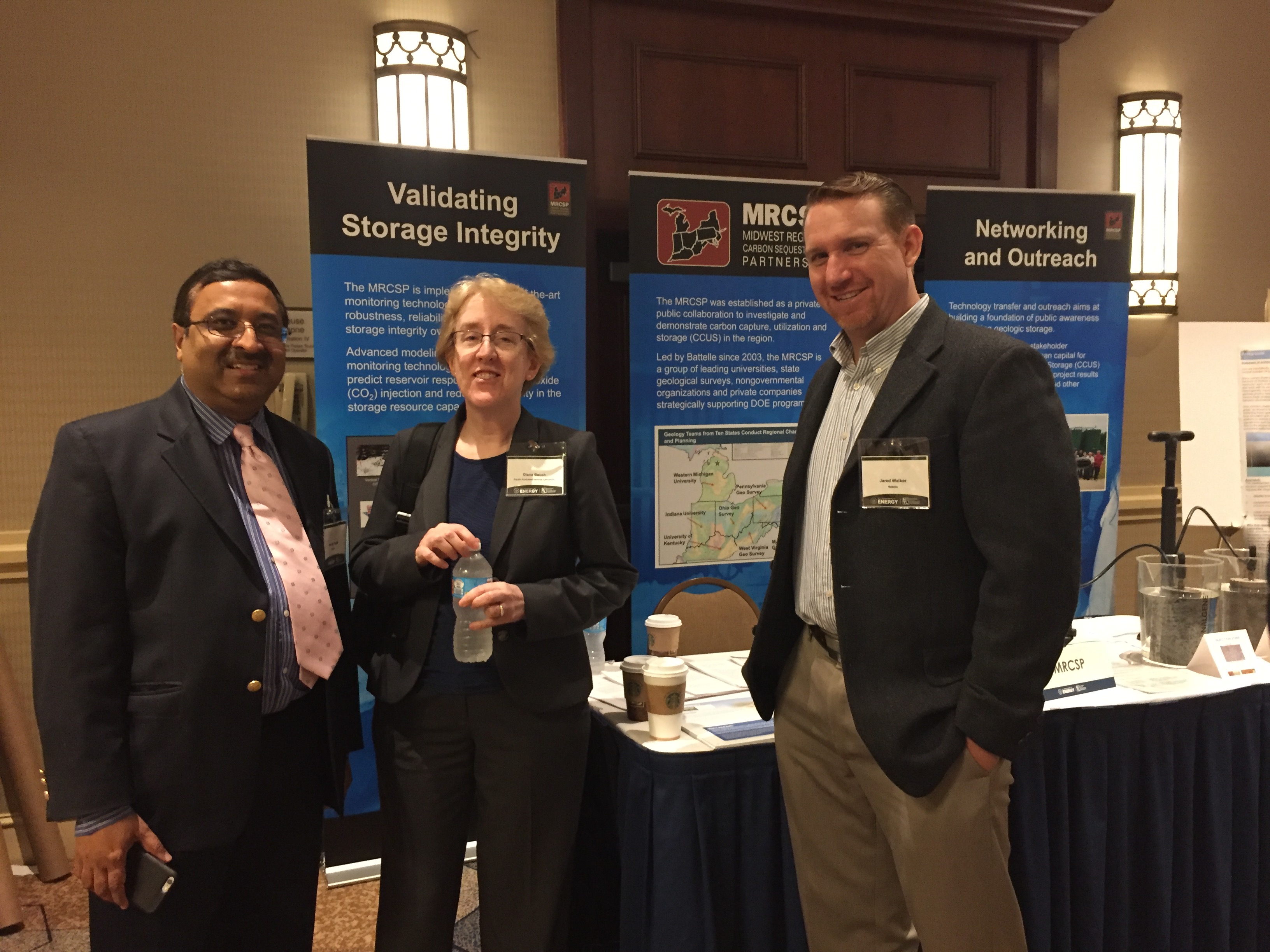Carbon Storage Atlas
- Project Highlights
- Unexpected Findings
- Advice for Storage Operators
- Project Outreach
- Project Commercialization
- The Midwest Regional Carbon Sequestration Partnership (MRCSP) covers 10 states: Delaware, Indiana, Kentucky, Maryland, Michigan, New Jersey, New York, Ohio, Pennsylvania, and West Virginia. MRCSP team members included numerous universities, state geological surveys, research institutions, and industry. The program objectives were to complete field tests of carbon capture, utilization, and storage (CCUS), regional mapping and opportunity assessment, and public and technical stakeholder outreach.
- MRCSP Phase I and Phase II included regional assessment, followed by multiple field pilot tests for geologic and terrestrial storag that showed regional variability in storage potential and exposed numerous new stakeholders to carbon capture and storage (CCS) technology, including almost all major energy companies operating in the MRCSP region.
- The MRCSP Phase III large-scale carbon dioxide (CO2) injection project was carried out in CO2-enhanced oil recovery (EOR) fields operated by Core Energy, LLC in the oil-bearing Niagaran Pinnacle reefs in the northern Michigan basin. The MRCSP monitoring period between 2013 and 2019 included net CO2 storage of more than 1.5 million metric tons, which is equivalent to carbon stored in 1.8 million acres of forest, or removing approximately 320,000 cars from roads. It also contributed to more than 1 million barrels in oil production and had a significant local economic impact.
- The diversity of oil fields available at the Phase III site allowed MRCSP to develop a research portfolio concurrent with growth in Core Energy operations. This included a variety of monitoring technologies, ranging for downhole pressure and temperature gauges, to satellite monitoring for uplift, seismic monitoring, and permanently installed fiber optic monitoring in wells.
One of the most surprising results from the Midwest Regional Carbon Sequestration Partnership (MRCSP) research was the finding of net-negative carbon dioxide (CO2) emissions from the greenhouse gas (GHG) life cycle analysis conducted on the large-scale test site. The project injected a large volume of CO2 in comparison to the amount of oil produced through CO2-enhanced oil recovery (EOR). This showed that a carbon capture, utilization, and storage (CCUS) project can be successful with the right technology, operations, and monitoring plans. Additionally, the extensive geologic characterization and modeling efforts emphasized the heterogeneity of the reservoirs and the impact the internal complexity has on CO2 injection and storage. No two reefs were found to behave the same, which made the geologic characterization critical to success.
Carbon dioxide (CO2) storage is a viable and feasible technology option in both saline reservoirs and in conjunction with CO2-ehanced oil recovery (EOR) operations for many parts of the world. The Midwest Regional Carbon Sequestration Partnership (MRCSP) region has significant storage potential; however, the storage resource varies with location based on geologic features across this large territory. The MRCSP research projects demonstrate that carbon capture, utilization, and storage (CCUS) may be successfully deployed in the Midwest United States for a variety of sources. For new operators who are not familiar with the subsurface resource assessment and utilization, several factors must be taken into account for developing projects, such as:
- Before starting a project, geologic characterization should be conducted to define the storage resources, injectivity, and containment – similar to the resource and reserve assessment performed by oil and gas companies.
- Due diligence in researching and preparing for the required modeling and monitoring, including baseline and post-injection, complexity of permitting requirements, legal property rights, and stakeholder aspects.
At greenfield sites, these requirements can lead to the need for significant upfront costs and time for developing a project from concept to operation stage. The operator should ensure access to the appropriate technical and legal/permitting/outreach team for this. Developing a CCUS project may initially seem overwhelming, but a good technical team will overcome technical and non-technical challenges. The upfront effort is worthwhile for reducing the technical and business uncertainties before large capital investments are made and for ensuring the long-term success of the project during operational and post-injection stages. Additional advice to new operators is to become familiar with geologic processes and concepts for CCUS, be prepared for uncertainty and changing approaches, and that geologic interpretations are more subjective than engineering approaches. The operators should also be familiar with the policy incentives, such as the 45Q tax credits and national and regional regulatory requirements that are catalyzing deployment at facilities with high-purity CO2 sources.
MRCSP has had a multipronged outreach program since its inception, guided by the social/technical outreach experts and conducted in collaboration with the technical team and host sites. The outreach strategies evolved as the program grew from Phase I general assessment to small-scale pilots in Phase II, before expanding to a large-scale test under Phase III. The outreach material and experiences from Phase II geologic storage pilots were of fundamental benefit for scale-up. The Phase II outreach was a highly collaborative effort with the host sites, which involved development of factsheets and information dissemination to the host site management, staff, local officials, and public stakeholders. This initial groundwork helped in gaining site access for field work and navigating the regulatory public comment periods at each site. The experience gained during Phase II small-scale pilot tests taught project developers to better understand and respond to stakeholder needs and contributed to best practices for public outreach and education for carbon storage projects.
Building on Phase II success, MRCSP developed and implemented a communications plan that focused on the Phase III large-scale injection test. As the project site moved from western Ohio saline reservoirs to the oil fields in northern Michigan, the outreach strategy was adjusted to account for ongoing oil/gas, and carbon dioxide (CO2)-enhanced oil recovery (EOR) operations and the resulting comfort level of local communities with planned research. The large-scale test in Michigan also benefitted from existing or new Class II EOR permits, previously negotiated site-access, and existing infrastructure. The local outreach could therefore be targeted towards selected stakeholders from regulatory, policy, and local official communities. The MRCSP outreach program sought to develop clear communications about the safety and importance of carbon capture and storage (CCS) technologies, which is critical for increasing public acceptance. Outreach materials were designed to address specific concerns, such as protection of groundwater resources, the costs and benefits of CCS, and comparisons with other sources of energy (e.g., renewable energy). Communicating the results of the large-scale project to a broad audience also was of particular interest to members of MRCSP.
In addition to the local stakeholders, the outreach program engaged regional, national, and global technical and policy stakeholders. This led to a large number of visits by interested developers, governmental officials, and researchers to the project sites. For example, the Midwest Regional Carbon Sequestration Partnership (MRCSP) hosted a very successful workshop of the International Energy Agency Greenhouse Gas R&D Programme (IEAGHG) Monitoring Network during 2017 in Traverse City, Michigan. The project developed an information exchange collaboration with the Hontomin project in Europe, which has a carbonate reservoir setting similar to the MRCSP Michigan site. The Michigan site also hosted delegations from China, Europe, and Australia, as well as a number of emerging technology companies.
Progress made and key findings for the large-scale test are being presented at conferences (such as Greenhouse Gas Control Technologies [GHGT] and Society of Petroleum Engineers [SPE] meetings) and other information exchanges, annual partners meetings, site visits, media (e.g., press releases, interviews), outreach materials, and the MRCSP website. A number of peer-reviewed and conference proceeding papers are also being published by the team. Finally, MRCSP convenes and participates in the Outreach Working Group, which is working to better understand and respond to questions about carbon capture and storage (CCS) and contributes to the U.S. Department of Energy’s (DOE) Carbon Storage Program Best Practices Manuals (BPMs).
The Michigan Basin Large-Scale Injection Project is helping to optimize strategies for carbon dioxide (CO2)-enhanced oil recovery (EOR) and storage at the commercial scale. The Northern Niagaran Pinnacle Reef Trend, containing more than 700 pinnacle reef structures, exhibits significant potential for supporting large-scale carbon capture, utilization, and storage (CCUS) operations. Many other oil fields in the Midwest Regional Carbon Sequestration Partnership (MRCSP) region also are candidates for CO2 utilization for EOR. Furthermore, the region contains abundant deep saline reservoirs, in many cases with overlapping oil fields, making stacked storage an option. Therefore, the methodologies for characterization, modeling, monitoring, and economic assessment developed and implemented in the MRCSP project can be used to support commercial deployment within a region of the United States that relies heavily on fossil energy. The methodologies, technical expertise, and lessons learned from this foundational project will contribute to the development of Best Practices Manuals (BPMs) for future EOR and commercial CO2 storage projects.
The success of the Michigan Basin Large-Scale Injection Project has garnered support to conduct detailed research on the carbon storage potential of additional areas in the MRCSP region. In conjunction with MRCSP, the Ohio Coal Development Office is sponsoring work to identify and characterize geologic formations in eastern Ohio as part of a long-term, collaborative effort to assess the potential for geologic storage of CO2 in the Ohio River Valley and adjacent areas. This includes examining major depleted oil and gas fields in Ohio, some of which are carbonate formations that are prime candidates for EOR. The validated methodologies, data, and results from the large-scale injection project will help guide characterization efforts and mitigation strategies. The MRCSP team has also evaluated storage opportunities in onshore and offshore reservoirs along the Atlantic coast.
Regional characterization is a significant component of developing a regional mitigation strategy. The MRCSP region has many large point sources of anthropogenic CO2 that are in close proximity to geologic storage resources. Geologists from each state are working jointly to define storage reservoirs suitable for existing and future sources of CO2, collaborate with oil and gas drillers to fill data gaps, and support industry in evaluating carbon storage options. The fundamental research completed by MRCSP will be of value to the regional economy by helping to develop robust and cost-effective means for reducing greenhouse gas (GHG) emissions.
The commercialization of CCUS also requires the right policy framework, consisting of carbon mitigation regulations, supporting incentive mechanisms to cover the cost (such as 45Q tax credits and infrastructure development legislations), public acceptance, and legal mechanisms to obtain pore space access and rights of way. The MRCSP region is currently poised to benefit from the 45Q tax credits, especially for high-purity sources such as the ethanol and ammonia plants. However, the deployment of carbon capture and storage (CCS) in power generation from coal- or gas-fired power plants will require additional technology improvements and regulatory mechanisms. The MRCSP experts are also working on a number of 45Q-related CCS projects across the United States.
The MRCSP research has been impactful beyond the MRCSP region. The expertise and lessons learned under MRCSP large-scale tests have been used by the team to support the Carbon Storage Assurance Facility Enterprise (CarbonSAFE) project in the mid-continent region, pilot-scale assessment in South Africa and Indonesia, and developing new projects across the United States.







